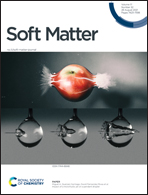Superhydrophobic μ-pillars via simple and scalable SLA 3D-printing: the stair-case effect and their wetting models†
Abstract
In nature, superhydrophobic surfaces (SHSs) exhibit microstructures with several roughness scales. Scalable fabrication and build-up along the X–Y plane represent the promise of 3D printing technology. Herein we report 3D printed microstructures with a dual roughness scale that achieves SHS using a readily available Formlabs stereolithography (SLA) printer. Pillar-like structure (PLS) arrangements with a wide range of geometrical shapes were 3D printed at three resolutions and two printing orientations. We discovered that a tilted printing direction enables a stair-case pattern on the μ-PLS surfaces, conferring them a μ-roughness that reduces the solid–liquid contact area. The programmed resolution governs the number of polymerized layers that give rise to the stepped pattern on the μ-PLS surfaces. However, this is reduced as the printing resolution increases. Also, all samples’ experimental contact angles were consistent with theoretical predictions from Cassie–Baxter, Wenzel, and Nagayama wettability models. The underlying mechanisms and governing parameters were also discussed. It is believed that this work will enable scalable and high throughput roughness design in augmenting future 3D printing object applications.



 Please wait while we load your content...
Please wait while we load your content...